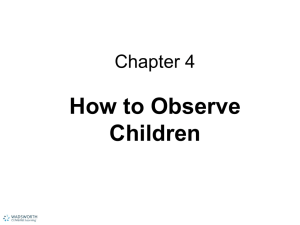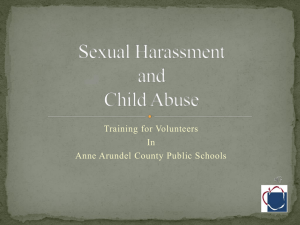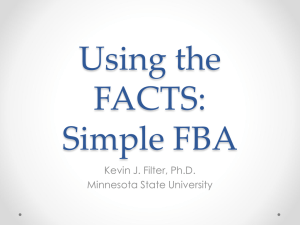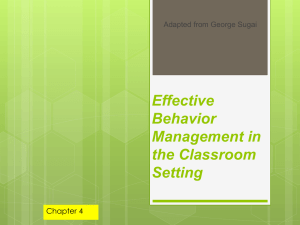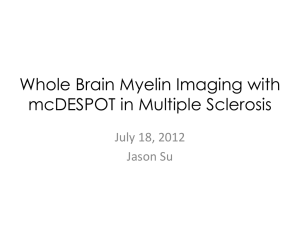Prevent - The Center on Early Learning
advertisement
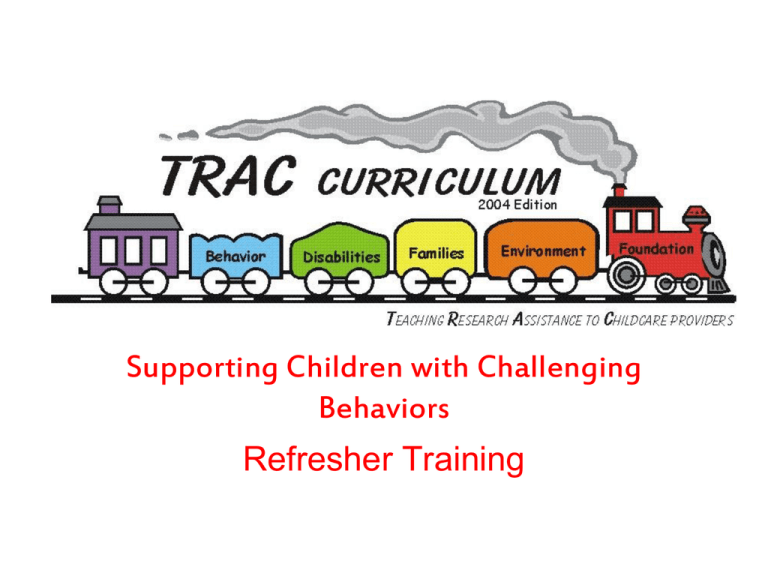
Supporting Children with Challenging Behaviors Refresher Training Training Schedule Supporting Children with Challenging Behaviors Unit Outcome Implement strategies to teach social skills and prevent and respond to behavioral problems in young children. Unit Objectives Knowledge of recommended practices and general principles of behavior intervention. Knowledge of typical and atypical social and emotional development. Utilize intervention strategies for preventing problem behaviors, teaching social skills and responding to challenging behaviors effectively. Unit Objectives Assess children’s behavior to determine function and develop a positive behavior support plan. Utilize simple measures of child progress to determine effectiveness of strategies and make intervention decisions. TRAC 2004 Units Recommended Practices Recommended Practices Inclusive Programming Developmentally appropriate environment Systematic teaching of social skills Analysis of child’s behavior Familycentered collaborative services Comprehensive behavior intervention General Principles of Behavior Intervention Reinforce positive behavior Prevent the behavior the behavior Encouraging alternative behaviors Provide a variety of behaviors Determine communicative intent Incorporate multi-element intervention Be consistent strategies Social Development Activity Social Development Puzzle Dimensions of Problem Behavior Intensity Frequency Duration Two Additional Considerations Variety Multiple Settings Patterns of Development for Behavior Problems “Difficult temperament” Chronic oppositional behavior Toddler Aggressiveness to adults and other children Infant Preschooler Stealing and truancy Elementary Favorable Conditions and Normal Development Intervention Strategies Prevent: Simplifying and/or Modifying Activities Alter task demands by simplifying or modifying activities Schedule preferred activities following nonpreferred activities Limit choices available Prevent: Clarifying and Communicating Expectations Use Circle visuals to clarify schedule Choice Wash Hands Snack Prevent: Clarifying and Communicating Expectations Use visuals to help clarify choices Library Writing Table Toys Prevent: Clarifying and Communicating Expectations Use visuals for the child to communicate Use a story board Prevent: Clarifying and Communicating Expectations Use visuals to communicate behavior expectations Prevent: Clarifying and Communicating Expectations Provide verbal or visual prompts or warnings Use scripted routines Use scripted responses Prevent: Individual Support Strategies Provide additional staff Use props for transitions Provide one-on-one adult attention Define personal space Teach: Strategies for Teaching Social Skills Teach alternative behaviors Model appropriate behaviors Target skills within activities Break down the social skills Reinforce the use of social skills Teach self regulation Use role play Respond: Strategies for Responding to Problem Behavior Ignore the behavior Provide assistance Verbally and/or Physically Assist 1. 2. 3. Acknowledge the child’s feelings Give feedback Provide an alternative behavior Respond: Strategies for Responding to Problem Behavior Ignore the behavior Provide assistance Redirect Loss of privilege or toy Time out or time away Time Out Use to allow the child time to calm down Use as a logical consequence Allow the child to control when they rejoin the group Use after children have been made aware of this as a consequence Use to help children learn self-control Positive Behavior Support Plans How it all Fits Together Social Skills Instruction Behavior Intervention Guidelines Positive Behavior Support Plans Strategies become more intense Problem Behaviors Definition Behaviors of such frequency, intensity, and duration that they interfere with the child’s ability to learn, relate socially to his peers, family members, others in the community, or pose health or safety issues to themselves or others. Positive Behavior Support Plan Checklist Behavior concern determined. Parents aware of initial concerns. Parental permission for evaluation obtained. Medical causes investigated. Environment and curriculum determined appropriate. Information regarding behaviors collected from parents, other staff member and related service providers. Parents have been invited to assist in the development of the plan. Functions of Behavior Gain attention from peer or adult Gain something Escape or Avoidance Intrinsic Steps to Developing a PBSP Step 1: Complete an observation of the child. ABC Observation Behavior Incident Log Steps to Developing a PBSP Step 2: Complete a reflective assessment of the child’s behavior. Positive Behavior Support Plan Development Form. Steps to Developing a PBSP Step 3: Develop individualized supports and interventions. Classroom form. Positive Behavior Support Plan Steps to Developing a PBSP Step 4: Design Monitoring System. Activity Review example PBSP Steps to Developing a PBSP Step 1: Complete an observation of the child. Step 2: Complete a reflective assessment of the child’s behavior. Step 3: Develop individualized supports and interventions. Step 4: Design monitoring system. Determining the Effectiveness of Strategies - Updating Programming Decisions – General Principles Decisions are made by comparing data Look for patterns Fade out unnecessary supports Do not make changes too soon Change one thing at a time Document the changes Data Collection and Analysis Steps Step 1: Observe child and collect data Social Competence Project Behavior Data Sheet Child's Name: Kal Jones Date Recording Initiated: Recording Terminated: October 13, 2002 Planning How Data is Collected Collect data on MWF from 10:00-11:00 am. Record a tally mark for each inappropriate attention seeking behavior you observe. How Data is Collected Target Dates Start data on 10/13 Target Dates Date Data Collection (dates of data collection in shaded boxes) Date/ Date/ Date/ Data Data Data 10/13 10/15 10/17 11111 11111 11111 111 1111 10/20 11111 1 10/22 11111 11111 10/24 11111 11 Date/ Data Date/ Data Date/ Data Programming Decision Date Data Data Total Summary Decision Plan/Notes margorP niatniaM ٱ margorP yfidoM ٱ 10/13 stroppuS esaerceDٱ 10/24 45/6 7.5/hour detelpmoC margorPٱ Date Data Data Total Summary Decision margorP niatniaM ٱ margorP yfidoM ٱ stroppuS esaerceD ٱ detelpmoC margorP ٱ Plan/Notes Data Collection and Analysis Steps Step 1: Observe child and collect data Step 2: Total the data Social Competence Project Behavior Data Sheet Kal Jones Child's Name: October Date Recording Initiated: Date Recording Terminated: Planning How Data is Collected Collect data on MWF from 10:00-11:00 am. Record a tally mark for each inappropriate attention seeking behavior you observe. How Data is Collected Target Dates Start data on 10/13 Target Dates Data Collection (dates of data collection in shaded boxes) Date/ Date/ Date/ Data Data Data 10/13 11111 111 10/15 11111 13, 2002 Programming Decision Date Data Total Data Summary 10/17 11111 1111 10/20 11111 1 10/22 11111 11111 10/24 11111 11 Date/ Data Date/ Data Date/ Data Decision Plan/Notes ? Maintain Program 10/13 10/24 ? Modify Program 45/6 7.5/hour ? Decrease Supports ? Program Completed Date Data Total Data Summary Decision Plan/Notes ? Maintain Program ? Modify Program ? Decrease Supports ? Program Completed How Data is Collected Target Dates Date/ Data Date/ Data Date/ Data Date Data Total Data Summary Decision ? Maintain Program ? Modify Program ? Decrease Supports ? Program Completed Plan/Notes Social Competence Project Behavior Data Sheet Kal Jones Child's Name: October Date Recording Initiated: Date Recording Terminated: Planning How Data is Collected Collect data on MWF from 10:00-11:00 am. Record a tally mark for each inappropriate attention seeking behavior you observe. How Data is Collected Target Dates Start data on 10/13 Target Dates Data Collection (dates of data collection in shaded boxes) Date/ Date/ Date/ Data Data Data 10/13 11111 111 10/15 11111 13, 2002 Programming Decision Date Data Total Data Summary 10/17 11111 1111 10/20 11111 1 10/22 11111 11111 10/24 11111 11 Date/ Data Date/ Data Date/ Data Decision Plan/Notes ? Maintain Program 10/13 10/24 ? Modify Program 45/6 7.5/hour ? Decrease Supports ? Program Completed Date Data Total Data Summary Decision Plan/Notes ? Maintain Program ? Modify Program ? Decrease Supports ? Program Completed How Data is Collected Target Dates Date/ Data Date/ Data Date/ Data Date Data Total Data Summary Decision ? Maintain Program ? Modify Program ? Decrease Supports ? Program Completed Plan/Notes Data Collection and Analysis Steps Step 1: Observe child and collect data Step 2: Total the data Step 3: Convert data to rate or percentage Social Competence Project Behavior Data Sheet Kal Jones Child's Name: October Date Recording Initiated: Date Recording Terminated: Planning How Data is Collected Collect data on MWF from 10:00-11:00 am. Record a tally mark for each inappropriate attention seeking behavior you observe. How Data is Collected Target Dates Start data on 10/13 Target Dates Data Collection (dates of data collection in shaded boxes) Date/ Date/ Date/ Data Data Data 10/13 11111 111 10/15 11111 13, 2002 Programming Decision Date Data Total Data Summary 10/17 11111 1111 10/20 11111 1 10/22 11111 11111 10/24 11111 11 Date/ Data Date/ Data Date/ Data Decision Plan/Notes ? Maintain Program 10/13 10/24 ? Modify Program 45/6 7.5/hour ? Decrease Supports ? Program Completed Date Data Total Data Summary Decision Plan/Notes ? Maintain Program ? Modify Program ? Decrease Supports ? Program Completed How Data is Collected Target Dates Date/ Data Date/ Data Date/ Data Date Data Total Data Summary Decision ? Maintain Program ? Modify Program ? Decrease Supports ? Program Completed Plan/Notes Data Collection and Analysis Steps Step 1: Observe child and collect data Step 2: Total the data Step 3: Convert data to rate or percentage Step 4:Compare current data with previous data Social Competence Project Behavior Data Sheet Kal Jones Child's Name: October Date Recording Initiated: Date Recording Terminated: Planning How Data is Collected Collect data on MWF from 10:00-11:00 am. Record a tally mark for each inappropriate attention seeking behavior you observe. How Data is Collected Target Dates Start data on 10/13 Target Dates Data Collection (dates of data collection in shaded boxes) Date/ Date/ Date/ Data Data Data 10/13 11111 111 10/15 11111 10/17 11111 1111 10/20 11111 1 10/22 11111 11111 10/24 11111 11 Date/ Data Date/ Data Date/ Data 13, 2002 Programming Decision Date Data Total Data Summary Decision Plan/Notes ? Maintain Program 10/13 10/24 ? Modify Program 45/6 7.5/hour ? Decrease Supports ? Program Completed Date Data Total Data Summary Decision Plan/Notes ? Maintain Program ? Modify Program ? Decrease Supports ? Program Completed How Data is Collected Target Dates Date/ Data Date/ Data Date/ Data Date Data Total Data Summary Decision ? Maintain Program ? Modify Program ? Decrease Supports ? Program Completed Plan/Notes Data Collection and Analysis Steps Step 1: Observe child and collect data Step 2: Total the data Step 3: Convert data to rate or percentage Step 4:Compare current data with previous data Step 5: Make programming decision Social Competence Project Behavior Data Sheet Kal Jones Child's Name: Date Recording Initiated: October 13, 2002 Planning How Data is Collected Collect data on MWF from 10:00-11:00 am. Record a tally mark for each inappropriate attention seeking behavior you observe. How Data is Collected Target Dates Start data on 10/13 Target Dates Date Recording Terminated: Data Collection (dates of data collection in shaded boxes) Date/ Date/ Date/ Data Data Data 10/13 11111 111 10/15 11111 Programming Decision Date Data Total Data Summary 10/17 11111 1111 10/20 11111 1 10/22 11111 11111 10/24 11111 11 Date/ Data Date/ Data Date/ Data Decision Plan/Notes ? Maintain Program 10/13 10/24 ? Modify Program 45/6 7.5/hour ? Decrease Supports ? Program Completed Date Data Total Data Summary Decision Plan/Notes ? Maintain Program ? Modify Program ? Decrease Supports ? Program Completed How Data is Collected Target Dates Date/ Data Date/ Data Date/ Data Date Data Total Data Summary Decision ? Maintain Program ? Modify Program ? Decrease Supports ? Program Completed Plan/Notes Data Collection and Analysis Steps Step 1: Observe child and collect data Step 2: Total the data Step 3: Convert data to rate or percentage Step 4:Compare current data with previous data Step 5: Make programming decision Step 6: Carry out programming decision Social Competence Project Behavior Data Sheet Kal Jones Child's Name: October Date Recording Initiated: Date Recording Terminated: Planning How Data is Collected Collect data on MWF from 10:00-11:00 am. Record a tally mark for each inappropriate attention seeking behavior you observe. How Data is Collected Target Dates Start data on 10/13 Target Dates Data Collection (dates of data collection in shaded boxes) Date/ Date/ Date/ Data Data Data 10/13 11111 111 10/15 11111 10/17 11111 1111 10/20 11111 1 10/22 11111 11111 10/24 11111 11 Date/ Data Date/ Data Date/ Data 13, 2002 Programming Decision Date Data Total Data Summary Decision Plan/Notes ? Maintain Program 10/13 10/24 ? Modify Program 45/6 7.5/hour ? Decrease Supports ? Program Completed Date Data Total Data Summary Decision Plan/Notes ? Maintain Program ? Modify Program ? Decrease Supports ? Program Completed How Data is Collected Target Dates Date/ Data Date/ Data Date/ Data Date Data Total Data Summary Decision ? Maintain Program ? Modify Program ? Decrease Supports ? Program Completed Plan/Notes Social Competence Project Classroom Positive Behavior Support Intervention Form Child’s Name: Kal Jones Plan Objective: Kal will reduce the number of inappropriate behaviors to gain attention to no more than 2 times per hour as measured by teacher observation for 2 consecutive weeks. Implementation Information Intervent Dates ion Number 1 Prevent Strategies and supports used to prevent the problem behaviors from occurring. Assistant teacher 10/13 welcomes Kal and spends 10 minutes oneon-one with him. Adults provide additional support when he is playing with Jerry. Teach Strategies used to teach appropriate social skills Adults verbally and with visual remind Kal to use child’s name to gain attention. Respond Strategies for responding when inappropriate behaviors are used for the targeted purpose Acknowledge his feelings/needs (“I know that you want Tim’s attention”) Show him the visual and give him an acceptable alternative (“But hitting is not okay. If you want Tim’s attention you need to use your words.”) Have him sit out for a short time. Closing Activities Implementation Plan Evaluation
